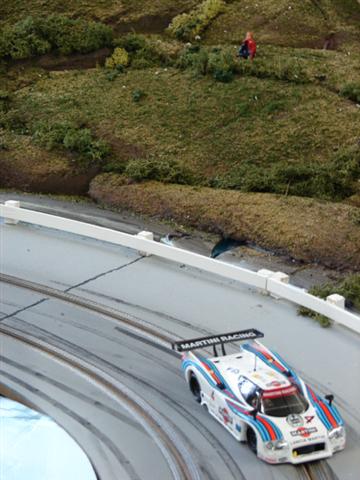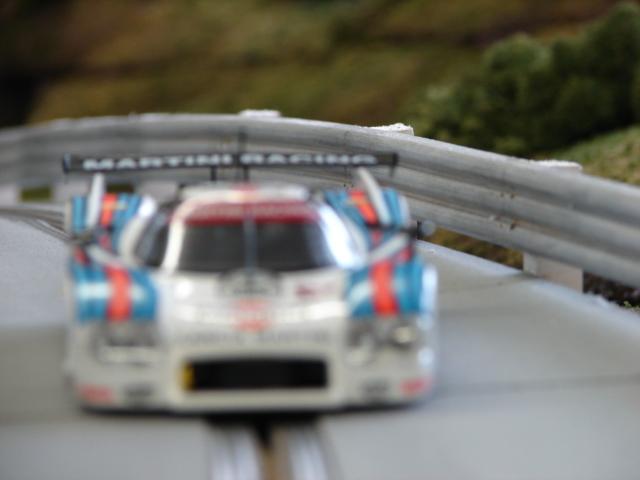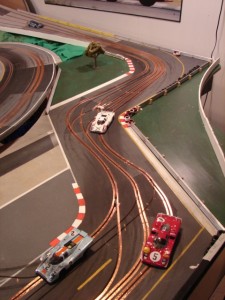Some track builders have been asking about the guardrails on the San Marino raod course. Dave used the same method of building a stout yet realistic guardrail when he had to create a robust 1/32 scale rail for the top of his high banked Monza turn on his own scale track. See Legends International Raceway in the “Our Tracks” page and refer to pictures of his Monza turn for more examples. He replicated that effort on Larry’s track below.


This steel Aramco guardrail is actually a silver painted length of 3/4" fluted wood molding available at most lumber yard and building centers.

In this close up you can see the detail that Dave added with a simple lead pencil to imitate fastners at each 3/8" X 3/8" post. The posts are all set 4 1/2" apart with a verticle line representing individual rails 12 feet long. Also note the shading with graphite to weather the guard rail and accentuate the fluting.
For your lane changer, we know that you use a 12 volt solenoid and return spring connected to a bent 1/8 steel rod to guide the shoe from one lane to the other. But when you run two cars (“A” and “B”) in a lane, both run very fast and near one another. Say car “A” is first, and “B” goes through second. But, both cars run nose to tail. How do the drivers of car A or B put on the switch and not disturb the other car? How the does the switch “know” who wants to change the lane and who does not want to do it? Can the A driver send a different signal to the switch than the B driver?
First see our Lane Changing Page.
The problem of a driver holding his lane change button down too long sounds worse than it is. Yes, both A and B driver’s buttons are wired in parallel to the same switch. No fancy electronics are really needed. The decisions are totally up to the driver. If driver A wants to be kicked off my track, he can just keep holding the button down as driver B  goes through the hairpin turn where the lane change switches are. There must be discipline in any form of racing. The decisions are totally up to the drivers. If they just change lanes blindly, they are going to ruin the race. Anyone model racing with two or more cars per lane must adhere to the same common sense rules that apply to all forms of racing, or be black flagged. We are not just watching toy cars zip around here! We are miniature racing. We are replicating an actual car race of a period with the finest scale models that we can build or buy. On digital race tracks the cars seem to be flying around like magnetized bumble bees stuck to the track. The track’s electronics on these sets, does the thinking for the drivers. The only time the cars look like real race cars is when they get picked up off the floor after they bash together at the switches! The secret to a good AC2Car routed track, which allows two cars to run in the same slot, is that the track needs to have it’s lane changing area designed just past a chicane, or hairpin. Just before the switches, the track necks down to force the field of cars to go through a tight roadway more slowly, and in single file. This not only minimizes shunts that occur as cars cross other lanes, but it allows the time to make a decision as to whether to stay in the regular lane or cross to the passing lane. Something that digital cannot provide. Again, holding the lane change button down as the other car goes over the lane change switch does accidentally happen, but it’s rare. The way we race, if a slower car is blocking, 1) The slow driver will let the faster car pass. No different than what is expected in real racing! 2) The faster car that needs to get by will drop back as he comes to the switch, because he not only has to negotiate the hairpin turn, or chicane slowly in single file, but he needs
goes through the hairpin turn where the lane change switches are. There must be discipline in any form of racing. The decisions are totally up to the drivers. If they just change lanes blindly, they are going to ruin the race. Anyone model racing with two or more cars per lane must adhere to the same common sense rules that apply to all forms of racing, or be black flagged. We are not just watching toy cars zip around here! We are miniature racing. We are replicating an actual car race of a period with the finest scale models that we can build or buy. On digital race tracks the cars seem to be flying around like magnetized bumble bees stuck to the track. The track’s electronics on these sets, does the thinking for the drivers. The only time the cars look like real race cars is when they get picked up off the floor after they bash together at the switches! The secret to a good AC2Car routed track, which allows two cars to run in the same slot, is that the track needs to have it’s lane changing area designed just past a chicane, or hairpin. Just before the switches, the track necks down to force the field of cars to go through a tight roadway more slowly, and in single file. This not only minimizes shunts that occur as cars cross other lanes, but it allows the time to make a decision as to whether to stay in the regular lane or cross to the passing lane. Something that digital cannot provide. Again, holding the lane change button down as the other car goes over the lane change switch does accidentally happen, but it’s rare. The way we race, if a slower car is blocking, 1) The slow driver will let the faster car pass. No different than what is expected in real racing! 2) The faster car that needs to get by will drop back as he comes to the switch, because he not only has to negotiate the hairpin turn, or chicane slowly in single file, but he needs  to see which side of the track the car in front decides to choose to race on. No one can pass you because the whole field of cars behind your car are forced into single file as they go through the tight hairpin or chicane. Just like real racing, a driver sees which side of the roadway the slower car chooses as it exits the turn and he takes the opposite side. This careful planning allows him the whole next lap, to beat the other car back to the lane switching area. Each time the cars slow and regroup at the hairpin, or a chicane, that decision is made again. No different than what Mario Andretti needed to do at narrow chicanes and hairpin turns on every lap, of every race, he ever ran in. If a driver on a track with two cars in one lane, does not race as the real cars do, than he deserves not to race on tracks such as these. He should go and spend triple digits on a digital set that does the thinking for him. That way he can watch cars fly around mindlessly, at least until one or two of them end up side swiped off the track.
to see which side of the track the car in front decides to choose to race on. No one can pass you because the whole field of cars behind your car are forced into single file as they go through the tight hairpin or chicane. Just like real racing, a driver sees which side of the roadway the slower car chooses as it exits the turn and he takes the opposite side. This careful planning allows him the whole next lap, to beat the other car back to the lane switching area. Each time the cars slow and regroup at the hairpin, or a chicane, that decision is made again. No different than what Mario Andretti needed to do at narrow chicanes and hairpin turns on every lap, of every race, he ever ran in. If a driver on a track with two cars in one lane, does not race as the real cars do, than he deserves not to race on tracks such as these. He should go and spend triple digits on a digital set that does the thinking for him. That way he can watch cars fly around mindlessly, at least until one or two of them end up side swiped off the track.




